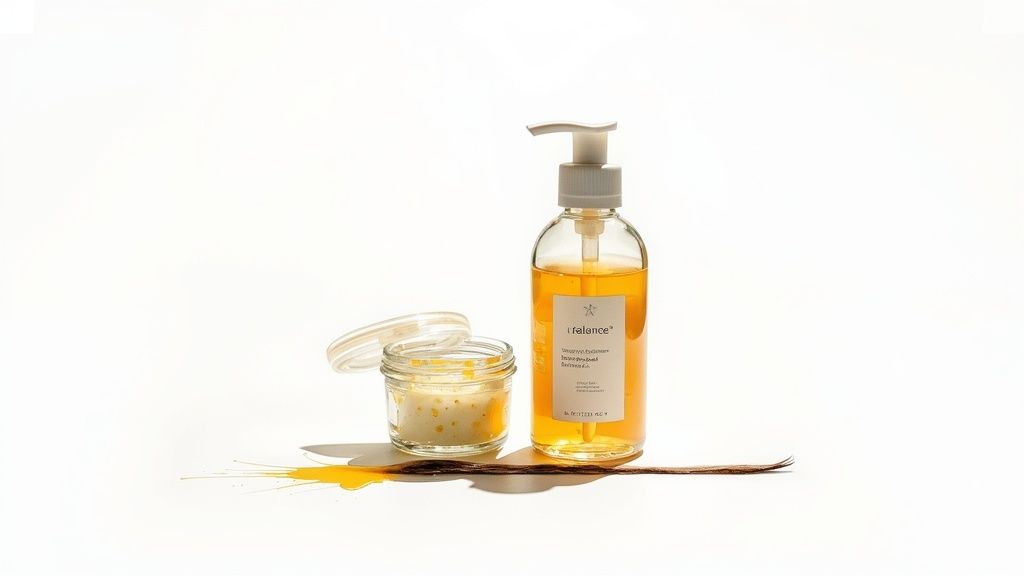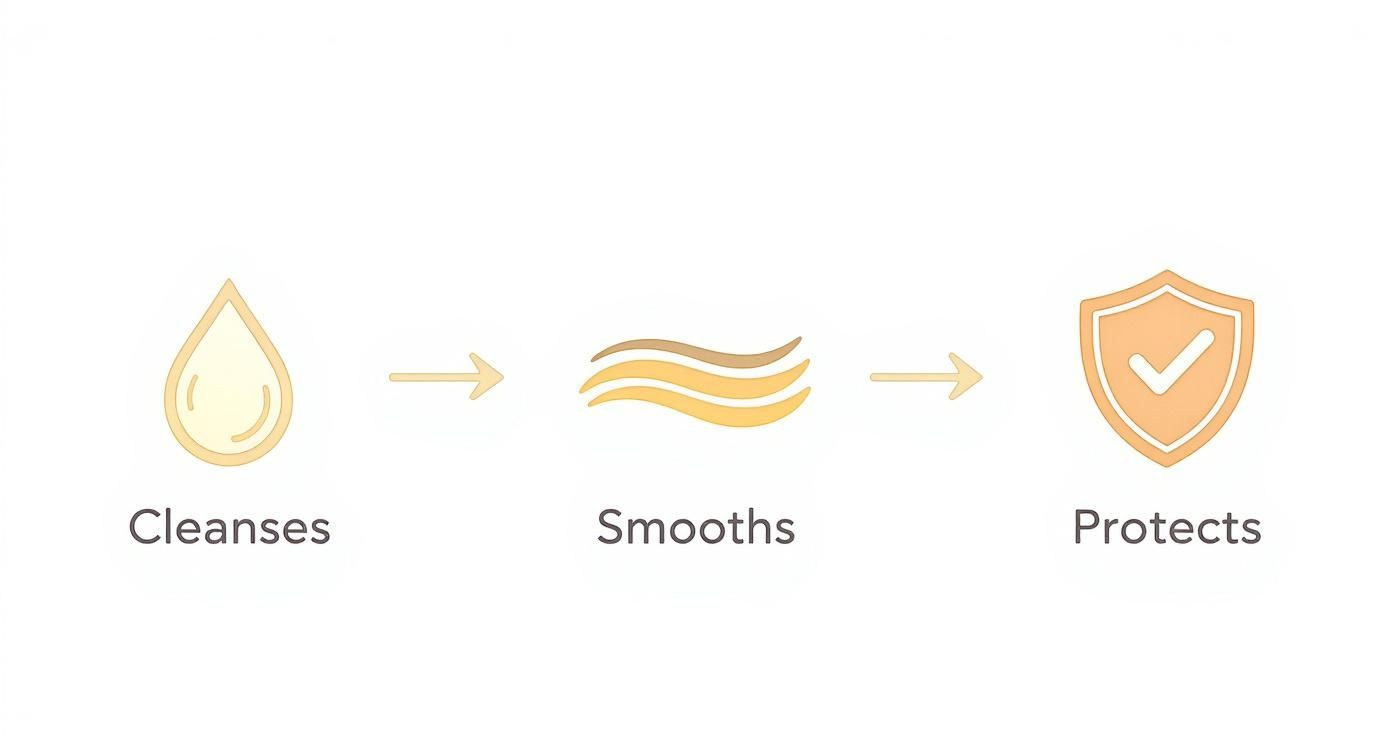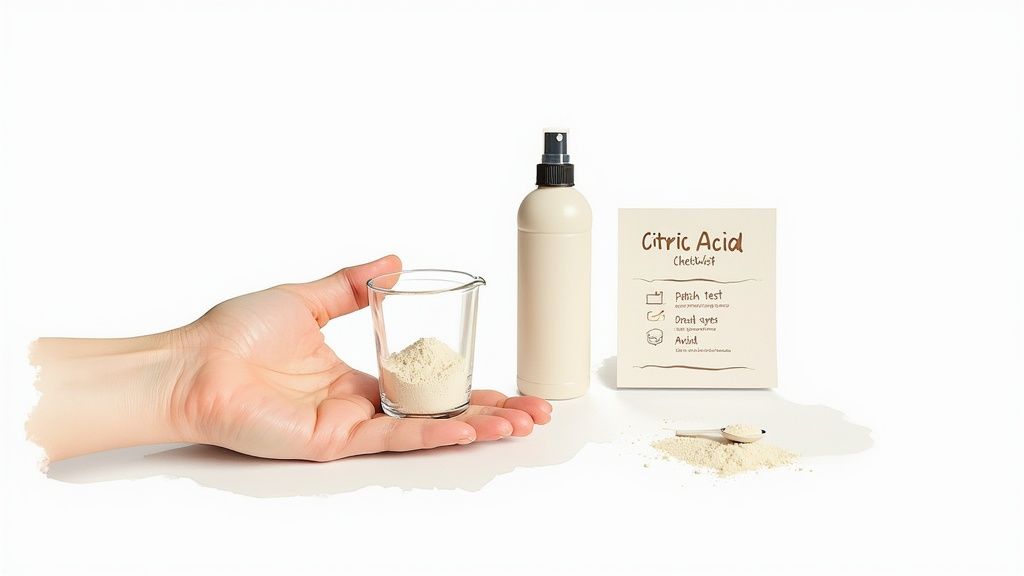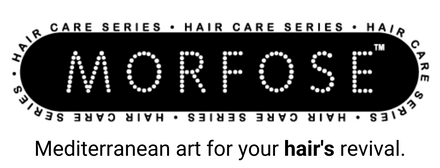citric acid on hair: Balance pH and Shine Safely
Posted by JENNIFER C.

Absolutely, using citric acid on hair can be a game-changer, but the secret lies in using it within properly formulated products. It’s not about squeezing a lemon on your head; it’s about harnessing its power to smooth your hair’s cuticle, boost shine, improve manageability, and even gently tackle mineral buildup from hard water.
What Is Citric Acid and Why Is It in Haircare?

When you spot "citric acid" on an ingredient label, it’s natural to picture a bowl of fresh lemons and oranges. While it's a star component of citrus fruits, the version in your favorite haircare products is a finely-tuned, powerful ingredient. It's a type of alpha-hydroxy acid (AHA) that acts as a quiet hero in countless shampoos, conditioners, and treatments.
Its job isn't to make your shampoo smell like a lemon grove. Instead, it performs a crucial technical role: balancing the pH level of the product. Think of it as a tiny, precise regulator, making sure the formula is perfectly optimized for your hair and scalp.
The Unseen Hero of Your Hair Products
Have you ever noticed how some cleansers can leave your hair feeling a bit rough or straw-like? That’s often because they have a slightly alkaline (high) pH, which forces the hair’s protective outer layer—the cuticle—to lift and swell. This is a one-way ticket to frizz, dullness, and tangles.
This is where citric acid steps in. It's added to formulations to lower the pH, bringing it back down to a more acidic level that’s much closer to your hair's happy place, which is naturally between 4.5 and 5.5.
This simple pH adjustment is what unlocks so many of the benefits we love:
- Smoother Hair Cuticles: By creating a more acidic environment, citric acid encourages those tiny "scales" on your hair cuticle to lie down flat and tight.
- Enhanced Shine: A smooth, flat cuticle acts like a mirror, reflecting light evenly. The result? A brilliant, natural shine that makes your hair look incredibly healthy.
- Improved Manageability: When cuticles are sealed, there's less friction between strands. This means fewer tangles, easier combing, and smoother styling.
Think of citric acid as the ingredient that helps all the other ingredients do their jobs better. By creating the perfect pH environment, it allows conditioning agents to cling to the hair shaft effectively and ensures cleansers can do their work without stripping away precious moisture.
Let’s take a quick look at how this plays out in the products you use every day.
Citric Acid in Your Hair Routine
Here's a quick look at how citric acid functions in hair care and the results you can expect.
| Function | Benefit for Hair | Common Product Type |
|---|---|---|
| pH Balancer | Seals the hair cuticle, reducing frizz and boosting shine. | Shampoos, Conditioners, Hair Masks |
| Chelating Agent | Binds to and removes mineral buildup from hard water. | Clarifying Shampoos, Detox Treatments |
| Antioxidant | Helps protect hair from environmental damage. | Leave-in Conditioners, Styling Products |
| Gentle Exfoliant | Can help remove dead skin cells from the scalp. | Scalp Scrubs, Pre-shampoo Treatments |
In short, it’s a multi-talented ingredient that improves both the product's performance and your hair's health.
Its effectiveness and versatility have cemented its place in the beauty world. In fact, the global citric acid market was valued at around USD 3.64 billion and is expected to keep growing, largely thanks to its widespread use in personal care. You can explore the full research on citric acid market trends to see just how big its impact is.
The Science Behind Hair pH and Citric Acid

To really get why citric acid works wonders on hair, we have to talk about a basic but crucial concept: pH. Everything, from the water in your shower to your favorite shampoo, has a pH level. Think of it as a scale from 0 to 14 that tells us how acidic or alkaline something is.
Pure water is smack in the middle at a neutral 7. Anything below that number is acidic, and anything above it is alkaline. Here's the key: your hair and scalp are naturally on the acidic side, happiest when their pH is between 4.5 and 5.5. Keeping it in this sweet spot is essential for maintaining the health of your hair's protective outer layer, the cuticle.
The Pinecone Analogy for Your Hair Cuticle
Let's use a simple analogy. Picture your hair's cuticle as the scales on a pinecone. When your hair is in its happy, acidic state, those scales lie down flat, smooth, and tightly sealed against one another. This creates a strong, slick surface that locks in moisture and reflects light, giving you that gorgeous, healthy shine.
But life happens. Hard water, harsh shampoos, and chemical treatments like hair color can throw this delicate balance off, pushing your hair's pH up into alkaline territory.
When the pH climbs, those "pinecone" scales on your cuticle stand up and open. An open cuticle is ground zero for a whole host of hair problems.
- Frizz and Roughness: When the cuticles are lifted, they snag on each other, creating friction that we feel as a rough texture and see as frizz.
- Dullness: An uneven, open surface can't reflect light properly. Instead, it scatters it, making your hair look flat and lifeless.
- Moisture Loss: Those gaps between the raised scales act like open doors, letting precious moisture escape and leaving your hair dry and brittle.
- Tangles and Breakage: Raised scales catch on neighboring strands, leading to frustrating knots and, ultimately, more breakage when you try to comb them out.
How Citric Acid Restores Balance
This is where citric acid steps in as a true hero for your hair. As a natural alpha-hydroxy acid (AHA), it has a low pH. When you apply it to your hair through a well-formulated product, it gently nudges your hair's surface pH back down into that ideal acidic zone.
This simple shift in pH is like a signal telling the "pinecone" scales of the cuticle to lie back down flat.
By re-sealing the hair cuticle, citric acid essentially closes the door on frizz, dullness, and moisture loss. It smooths the hair's surface, instantly boosting its ability to reflect light and retain hydration, leading to silkier, shinier, and more manageable strands.
This scientific principle isn't just a neat trick; it's the foundation of many professional-grade repair systems, including bond-building treatments that need an acidic environment to work effectively. Bringing the pH back into balance is a critical step in strengthening hair from the inside out.
Knowing this empowers you to make smarter choices for your hair. You can dive deeper into how this works by understanding your hair type in our detailed guide. It’s about more than just getting your hair clean—it’s about creating the perfect chemical environment for it to truly flourish.
Unlocking the Benefits of Citric Acid for Your Hair
Knowing the science behind hair pH is great, but what really counts is seeing and feeling the difference in your own hair. Using citric acid on hair isn't just some abstract theory; it delivers real, noticeable benefits that do a lot more than just add a little shine. Think of it as a gentle reset button for your strands.
One of its most popular jobs is as a clarifying agent. Over time, your hair can get coated with a dull, filmy layer of minerals from hard water—we're talking about things like calcium and magnesium. This buildup weighs your hair down, leaving it looking flat and feeling coarse. Citric acid is a natural chelator, meaning it grabs onto these minerals and whisks them away when you rinse, letting your hair’s true vibrancy and softness shine through.
A Healthier Scalp Environment
The good news doesn't stop with your hair strands. A balanced pH is just as important for your scalp. When your scalp becomes too alkaline, it can lead to frustrating issues like dryness, itchiness, and irritation. By helping keep your scalp at its naturally acidic sweet spot, citric acid promotes a healthy environment for strong, vibrant hair to grow right from the root.
Simply put, a happy scalp means happy follicles, which is the foundation for your best hair.
Enhanced Color Vibrancy and Protection
If you color your hair, citric acid can be a game-changer. When your hair cuticles are sealed down flat, those precious color molecules are locked in tight inside the hair shaft. This simple act helps prevent your color from washing out and fading too quickly, keeping that expensive salon look richer and more brilliant for weeks longer. It’s like a protective shield for your investment.
By smoothing the hair's outer layer, citric acid not only locks in color but also creates a more uniform surface. This allows light to reflect more evenly, making your color appear more luminous and dimensional.
The Everyday Advantages You Can Expect
Bringing products with citric acid into your routine adds up to real, day-to-day improvements. When you combine all these benefits, you get hair that’s just easier to handle, style, and love.
Here are some of the practical results you might notice:
- Reduced Frizz and Flyaways: A sealed cuticle is your best defense against humidity, meaning your hair stays much sleeker and more controlled.
- Effortless Detangling: With less friction between strands, your comb and brush will glide right through, leading to fewer knots and less breakage.
- Improved Softness and Texture: Getting rid of that gritty mineral buildup restores a silky, touchable feel. This is a huge step if you're trying to figure out how to revive dull hair and restore its shine.
These widespread benefits explain why you'll find citric acid in everything from daily shampoos to intensive salon treatments. In fact, the global market for citric acid reached a massive 2.81 million tons, and it's still growing, which shows just how vital it has become in the world of personal care. You can learn more about the rising demand for citric acid in cosmetics and see why it's a staple ingredient.
How to Create a Safe DIY Citric Acid Hair Rinse
So, you're ready to see what citric acid can do for your hair? Making your own rinse at home is incredibly easy, but let's be clear about one thing: safety is everything. Getting the dilution right is the most important part. A mixture that's too strong can backfire, leading to dryness or irritation, so we have to be precise.
This guide will show you exactly how to mix a gentle—but seriously effective—rinse using simple, food-grade citric acid. Adding this one step to your routine can be a total game-changer, especially if you're dealing with the dulling effects of hard water. Think of it as hitting the reset button for your hair.
This infographic breaks down how a simple rinse can work to cleanse, smooth, and protect your hair.

As you can see, it's a simple chain reaction. First, it lifts away mineral buildup. That allows the hair cuticle to lie flat and smooth, which ultimately leaves your hair feeling protected and looking vibrant.
The Basic Recipe and Ratios
For a standard, go-to rinse, you only need two things: food-grade citric acid powder and distilled or purified water. It's best to use distilled water here because it's free of the very minerals you're trying to wash away from your hair.
The key is to keep the mixture very, very weak to ensure it's gentle on your hair and scalp.
- Citric Acid: ¼ teaspoon of food-grade powder
- Water: 2 cups (16 ounces or approximately 500 ml)
Just mix these together in a clean spray bottle or an applicator bottle. Shake it until the powder has completely dissolved. And please, never add more powder thinking it will give you better results. This highly diluted ratio is where the magic happens—safely.
Step-by-Step Application Guide
To get the most out of your DIY rinse, you'll want to use it as the final step of your shower routine. Just follow these simple steps after you’ve already shampooed and conditioned.
- Wash and Condition as Usual: Go through your normal routine. Make sure you rinse your conditioner out thoroughly.
- Gently Squeeze Out Excess Water: Once the conditioner is rinsed, gently squeeze the extra water from your hair. You want it damp, not sopping wet.
- Apply the Citric Acid Rinse: Slowly pour or spray the solution all over your head. You want to saturate your hair from roots to ends. Use your fingers to comb it through gently.
- Let It Sit (Briefly): This is a quick step! Let the rinse sit on your hair for just 1-2 minutes. That's all the time it needs to lower your hair's pH and do its thing. Don't leave it in any longer.
- Rinse Thoroughly with Cool Water: Finish with a complete rinse using cool or lukewarm water. The cooler temperature gives the hair cuticle an extra nudge to seal shut, locking in shine.
Safety First: Always Perform a Patch Test Before you douse your head in the new rinse, it's smart to test a small amount on a hidden patch of skin, like behind your ear or on your inner arm. Give it 24 hours to make sure you don't have any kind of reaction. Also, be incredibly careful to keep it out of your eyes. If any gets in, flush them immediately with lots of water.
For more great ideas, take a look at our guide to other DIY hair care homemade treatments for luscious locks you can whip up in your kitchen. This simple rinse is a fantastic first step toward taking your hair's health into your own hands.
Simple DIY Citric Acid Rinse Guide
Need a quick reference for mixing your rinse? This table breaks down a couple of options for creating a safe and effective citric acid hair rinse based on what your hair needs.
| Rinse Strength | Citric Acid to Water Ratio | Recommended For |
|---|---|---|
| Standard | ¼ teaspoon to 2 cups (16 oz) of water | First-time users, regular maintenance, and sensitive scalps. |
| Clarifying | ½ teaspoon to 2 cups (16 oz) of water | Occasional use (once a month) for stubborn hard water buildup or swimmers. |
Always start with the Standard strength if you're new to citric acid rinses. You can always adjust later, but it's best to see how your hair reacts to the gentler formula first.
Potential Risks and Who Should Be Cautious
While a citric acid rinse can be a game-changer for your hair, it's definitely not a one-size-fits-all miracle. Like any potent ingredient, it has its limits, and knowing when to hold back is just as important as knowing when to use it. The biggest pitfalls? Overdoing it or mixing up a DIY rinse that's way too strong.
Think of it like this: a little acidity is great for sealing the hair cuticle, but too much can be a problem. An overly aggressive acidic solution can actually strip away your hair’s protective natural oils. This leaves it feeling parched, brittle, and much more likely to snap. It’s all about finding that sweet spot—a gentle nudge to the right pH is fantastic, but a hard shove can throw everything out of balance.
When to Proceed with Caution
Some hair types and scalp conditions just don't play well with strong ingredients, so you'll want to be extra careful. If any of these sound like you, it's probably best to skip the DIY route altogether or at least chat with your stylist first.
- Sensitive Scalps: If you're someone whose scalp gets easily irritated, red, or itchy, applying any kind of acid—even a properly diluted one—might cause a flare-up.
- Active Skin Conditions: For anyone dealing with eczema, psoriasis, or any open cuts or sores on the scalp, putting citric acid on the area is a definite no-go. It can sting badly and make inflammation worse.
- Recently Processed Hair: Hair that's fresh from a bleach, perm, or chemical relaxing service is in a very delicate state. Its cuticle is already wide open and vulnerable, so hitting it with a strong acid right away can cause even more damage. Give your hair at least a week to recover after these treatments.
The fact that citric acid is a go-to ingredient in professionally made products really speaks to its benefits when used correctly. The global luxury hair care market, valued at a massive USD 23.2 billion, frequently features citric acid in premium shampoos and treatments. It’s a key part of what makes them perform so well while still being gentle. You can dive deeper into the growth of the luxury hair care market to see how quality ingredients are shaping the industry.
Debunking a Common Myth
Let's clear up one of the most common misconceptions out there: the idea that citric acid will lighten or bleach your hair. That’s simply not true.
Citric acid is not a bleaching agent. The "brightening" effect people rave about is purely from its clarifying power. It strips away the dull, cloudy mineral film left by hard water, revealing your hair’s true, vibrant color and shine that was hiding underneath. It restores your natural luster—it doesn't chemically alter your hair's pigment.
So, you can relax. A properly diluted citric acid rinse is going to make your hair clearer and shinier, not change its color. By keeping these potential risks in mind and knowing when to be cautious, you can make sure your experience with citric acid is nothing but a success.
Common Questions About Using Citric Acid on Hair

It's totally normal to have a few questions before trying something new like a citric acid on hair treatment, even after hearing about all the great benefits. We get it. To make sure you feel completely comfortable, we've put together answers to the questions we hear most often.
Think of this as your personal cheat sheet—a way to clear up any lingering doubts so you can use citric acid with confidence, whether you’re mixing up a DIY rinse or grabbing a professionally formulated product.
How Often Should I Use a Citric Acid Rinse?
This is a great question, and the honest answer is: it depends. The right frequency really comes down to your hair type and, just as importantly, the kind of water you have at home. There’s no one-size-fits-all rule here, so the best strategy is to start slow and see how your hair reacts. Your hair will tell you what it needs.
Here are a few starting points to guide you:
- For Oily Hair or Heavy Buildup: If you’re fighting against very hard water or your hair feels weighed down all the time, using a rinse about once a week is a solid starting point. This should help keep things feeling fresh and clean.
- For Normal to Dry Hair: If buildup isn't a huge issue for you, a rinse every 2 to 4 weeks is probably all you need to keep that shine and softness going without overdoing it.
Can Citric Acid Lighten My Hair?
This is probably the biggest myth out there, so let's set the record straight: no, citric acid will not bleach or lighten your hair's natural pigment. It simply doesn't have the chemical properties to do that.
So why do people think it does? The "brightening" effect they see is actually the result of some serious deep cleaning. Citric acid is fantastic at dissolving the dull, sometimes yellowish mineral film that hard water leaves behind. By washing that gunk away, it reveals the vibrant, true color that was hiding underneath.
Your hair isn't actually getting lighter—it's just getting remarkably cleaner. The change can be so noticeable that it's easy to mistake for a lightening effect.
Is a Citric Acid or ACV Rinse Better?
Ah, the classic showdown: citric acid vs. apple cider vinegar (ACV). Both are popular DIY options for balancing hair pH, and both work well. The best one for you really boils down to a few key differences and your personal preference.
| Feature | Citric Acid Rinse | Apple Cider Vinegar (ACV) Rinse |
|---|---|---|
| Odor | Completely odorless. | Has a very strong, distinct vinegar smell. |
| Concentration | Super concentrated—you only need a tiny bit. | Much less concentrated, so you need more per rinse. |
| Convenience | A stable powder that's easy to store and measure. | A liquid that can be a bit trickier to measure precisely. |
| Effectiveness | Both are great at lowering hair's pH and kicking buildup to the curb. | Both are great at lowering hair's pH and kicking buildup to the curb. |
Honestly, you can't go wrong with either in terms of results. But if the potent smell of vinegar makes you wrinkle your nose, citric acid is the clear winner.
Will This Damage My Color-Treated Hair?
When used correctly, a properly diluted citric acid rinse can actually be your colored hair's best friend. By helping to seal the hair cuticle, it effectively locks in those expensive color molecules, keeping them from washing down the drain. This can make a real difference in extending the life of your color and keeping it looking rich and vibrant.
The one big caveat? Hold off on any DIY acidic rinses for at least a few days to a week right after you get your hair colored. Your hair is a bit more sensitive and porous immediately after a chemical service, so it's wise to give it some time to settle down first.
Ready to get that shine and softness without all the guesswork? The Morfose collection features expertly crafted products that use the power of pH-balancing ingredients to repair, protect, and restore your hair.
Explore our color-safe and restorative haircare solutions at Morfose today!


